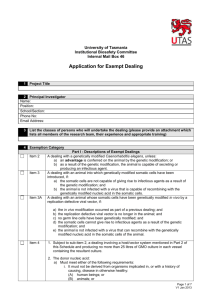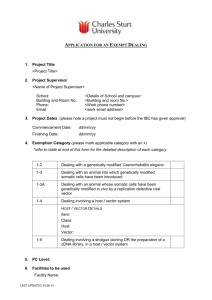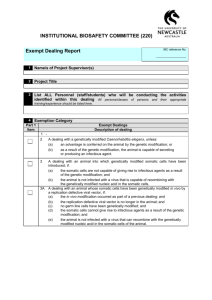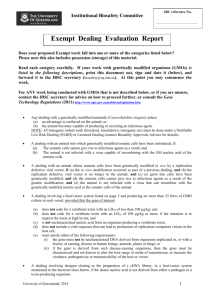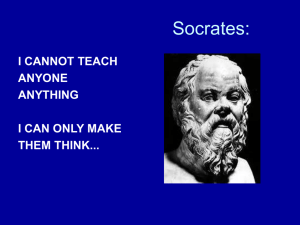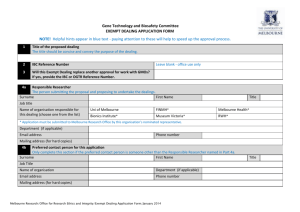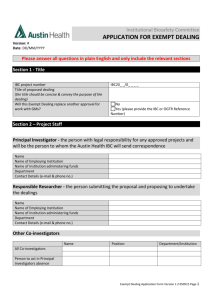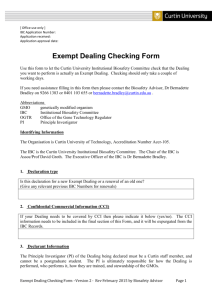Exempt Dealing - St. Vincent`s Hospital Melbourne
advertisement
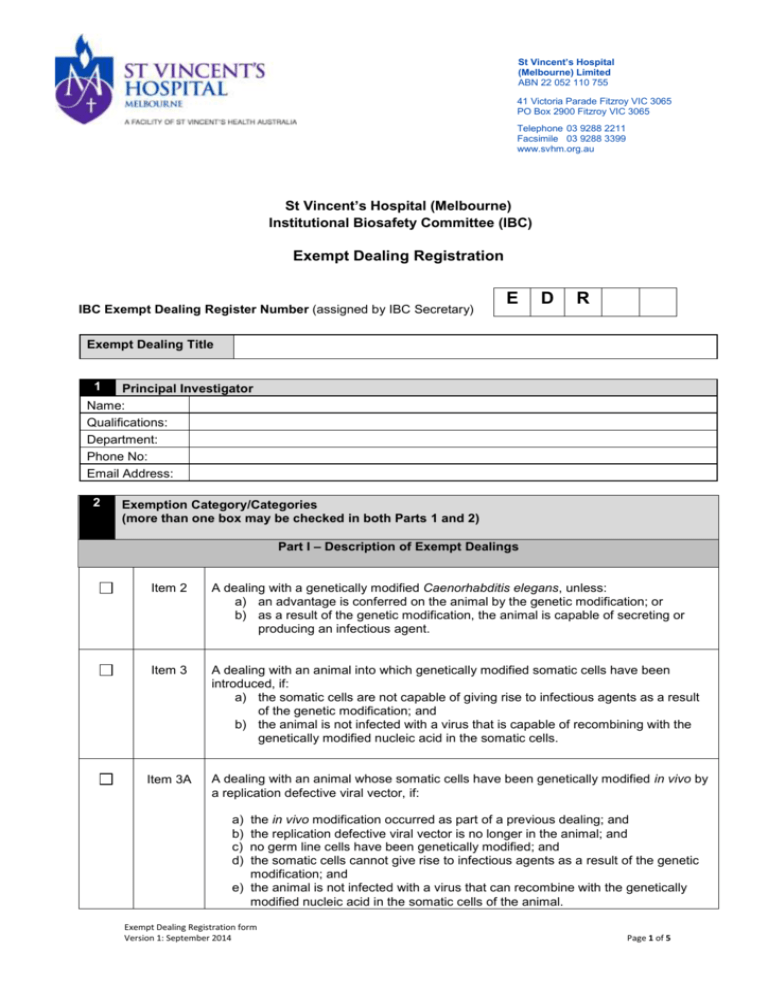
St Vincent’s Hospital (Melbourne) Limited ABN 22 052 110 755 41 Victoria Parade Fitzroy VIC 3065 PO Box 2900 Fitzroy VIC 3065 Telephone 03 9288 2211 Facsimile 03 9288 3399 www.svhm.org.au St Vincent’s Hospital (Melbourne) Institutional Biosafety Committee (IBC) Exempt Dealing Registration IBC Exempt Dealing Register Number (assigned by IBC Secretary) E D R Exempt Dealing Title 1 Principal Investigator Name: Qualifications: Department: Phone No: Email Address: 2 Exemption Category/Categories (more than one box may be checked in both Parts 1 and 2) Part I – Description of Exempt Dealings Item 2 A dealing with a genetically modified Caenorhabditis elegans, unless: a) an advantage is conferred on the animal by the genetic modification; or b) as a result of the genetic modification, the animal is capable of secreting or producing an infectious agent. Item 3 A dealing with an animal into which genetically modified somatic cells have been introduced, if: a) the somatic cells are not capable of giving rise to infectious agents as a result of the genetic modification; and b) the animal is not infected with a virus that is capable of recombining with the genetically modified nucleic acid in the somatic cells. Item 3A A dealing with an animal whose somatic cells have been genetically modified in vivo by a replication defective viral vector, if: a) b) c) d) the in vivo modification occurred as part of a previous dealing; and the replication defective viral vector is no longer in the animal; and no germ line cells have been genetically modified; and the somatic cells cannot give rise to infectious agents as a result of the genetic modification; and e) the animal is not infected with a virus that can recombine with the genetically modified nucleic acid in the somatic cells of the animal. Exempt Dealing Registration form Version 1: September 2014 Page 1 of 5 Item 4 1. Subject to sub-item 2, a dealing involving a host/vector system mentioned in Part 2 of this Schedule (see below) and producing no more than 25 litres of GMO culture in each vessel containing the resultant culture. 2. The donor nucleic acid: a) Must meet either of the following requirements: i. It must not be derived from organisms implicated in, or with a history of causing, disease in otherwise healthy: (A) human beings; or (B) animals; or (C) plants; or (D) fungi; ii. It must be characterised and the information derived from its characterisation show that it is unlikely to increase the capacity of the host or vector to cause harm; b) Must not code for a toxin with an LD50 of less than 100 μg/kg; and c) Must not code for a toxin with an LD50 of 100 μg/kg or more, if the intention is to express the toxin at high levels; and d) Must not be uncharacterised nucleic acid from a toxin-producing organism; and e) Must not include a viral sequence unless the donor nucleic acid: i. Is missing at least 1 gene essential for viral multiplication that: (A) is not available in the cell into which the nucleic acid is introduced; and (B) will not become available during the dealing; and ii. cannot restore replication competence to the vector. Item 5 A dealing involving shot-gun cloning, or the preparation of a cDNA library, in a host/vector system mentioned in item 1 of Part 2 of Schedule 2 (see below), if the donor nucleic acid is not derived from either: a) A pathogen; or b) A toxin-producing organism. Exempt Dealing Registration form Version 1: September 2014 Page 2 of 5 Part 2 - Host/vector systems for exempt dealings Class Host Vector 1 Bacteria Escherichia coli K12, E. coli B, E. coli C or E. coli Nissle 1917 – any derivative that does not contain: (a) generalised transducing phages; or (b) genes able to complement the conjugation defect in a non-conjugative plasmid 1. Non-conjugative plasmids 2. Bacteriophage (a) lambda (b) lambdoid (c) Fd or F1 (e.g. M13) 3. None (non-vector systems Bacillus – specified species – asporogenic strains with a reversion frequency of less than 10–7: (a) B. amyloliquefaciens (b) B. licheniformis (c) B. pumilus (d) B. subtilis (e) B. thuringiensis Pseudomonas putida – strain KT 2440 Streptomyces – specified species: (a) S. aureofaciens (b) S. coelicolor (c) S. cyaneus (d) S. griseus (e) S. lividans (f) S. parvulus (g) S. rimosus (h) S. venezuelae Agrobacterium radiobacter Agrobacterium rhizogenes — disarmed strains Agrobacterium tumefaciens — disarmed strains Lactobacillus Lactococcus Lactis Oenococcus oeni syn. Leuconostoc oeni Pediococcus Photobacterium angustum Pseudoalteromonas tunicate Rhizobium (including the genus Allorhizobium) Sphingopyxis alaskensis syn. Sphingomonas alaskensis Streptococcus thermophilis Synechococcus — specified strains: (a) PCC 7002 (b) PCC 7942 (c) WH 8102 Synechocystis species — strain PCC 6803 Vibrio cholerae CVD103-HgR Exempt Dealing Registration form Version 1: September 2014 1. Non-conjugative plasmids 2. Plasmids and phages whose host range does not include B. cereus, B.anthracis or any other pathogenic strain of Bacillus 3. None (non-vector systems) 1. Non-conjugative plasmids including certified plasmids: pKT 262, pKT 263, pKT 264 2. None (non-vector systems) 1. Non-conjugative plasmids 2. Certified plasmids: SCP2, SLP1, SLP2, PIJ101 and derivatives 3. Actinophage phi C31 and derivatives 4. None (non-vector systems) 1. Non-tumorigenic disarmed Ti plasmid vectors, or Ri plasmid vectors 2. None (non-vector systems) 1. Non-conjugative plasmids 2. None (non-vector systems Page 3 of 5 2 Fungi Kluyveromyces lactis Neurospora crassa – laboratory strains Pichia pastoris Saccharomyces cerevisiae Schizosaccharomyces pombe Trichoderma reesei Yarrowia lipolytica 1. All vectors 2. None (non-vector systems) 3 Slime moulds Dictyostelium species 1. Dictyostelium shuttle vectors, including those based on the endogenous plasmids Ddp1 and Ddp2 2. None (non-vector systems) 4 Tissue culture Any of the following if they cannot spontaneously generate a whole animal: (a) animal or human cell cultures (including packaging cell lines); (b) isolated cells, isolated tissues or isolated organs, whether animal or human; (c) early non-human mammalian embryos cultured in vivo Either of the following if they are not intended, and are not likely without human intervention, to vegetatively propagate, flower or regenerate into a whole plant: (a) plant cell cultures; (b) isolated plant tissues or organs 1. Non-conjugative plasmids 2. Non-viral vectors, or defective viral vectors unable to transducer human cells 3. Avipox vectors (attenuated vaccine strains) 4. Baculovirus (Autographa californica nuclear polyhedrosis virus), polyhedron minus 5. None (non-vector systems) 1. Non-tumorigenic disarmed Ti plasmid vectors, or Ri plasmid vectors, in Agrobacterium tumefaciens, Agrobacterium radiobacter or Agrobacterium rhizogenes 2. Non-pathogenic viral vectors 3. None (non-vector systems) Definitions: In this Schedule: Code for, in relation to a toxin, means to specify the amino acid sequence of the toxin. Non-conjugative plasmid means a plasmid that is not self-transmissible, and includes, but is not limited to, non-conjugative forms of the following plasmids: (a) Bacterial artificial chromosomes (BACs); (b) Cosmids; (c) P1 artificial chromosomes (PACs); (d) Yeast artificial chromosomes (YACs). Non-vector system means a system by which donor nucleic acid is introduced (for example, by electroporation or particle bombardment) into a host in the absence of a nucleic acid-based vector (for example, a plasmid, viral vector or transposon). Exempt Dealing Registration form Version 1: September 2014 Page 4 of 5 3 Summary of Exempt Dealing Briefly outline the dealing(s), including a broad description of the types of GMOs and how they are generated and/or used. (This should be written using plain English) 4 List all Facilities to be used Exempt dealings may be conducted in PC1 facilities. However in line with AS/NZS 2243.3, if human or animal tissues or risk group 2 micro-organisms are involved, the dealing must be conducted in a PC2 facility. Uncertified PC1 Laboratory OGTR Certified PC1 Laboratory OGTR Certified PC2 Laboratory OGTR Certified PC3 Laboratory OGTR Certified PC1 Animal Facility OGTR Certified PC2 Animal Facility Other (Please specify): Please list the Building Name/s, Room Number/s and Certification Number/s: 5 Principal Investigator Declaration 1. 2. 3. 4. I confirm that the information provided in this application is true and correct I agree to uphold all relevant guidelines of the OGTR during the conduction of this dealing I agree to report any deviations and/or variations to the IBC as soon as possible. I agree to abide by the OHS requirements of the Accredited Organisation within which all work will take place NAME: SIGNATURE: Exempt Dealing Registration form Version 1: September 2014 DATE: Page 5 of 5
